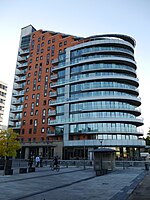A219 road
All pages needing cleanupGeographic coordinate listsInfobox road instances in the United KingdomInfobox road maps tracking categoryLists of coordinates ... and 7 more
London road stubsRoads in EnglandRoads in LondonStreets in the London Borough of Hammersmith and FulhamStreets in the London Borough of WandsworthTransport in the London Borough of MertonUse British English from February 2013

The A219, is a road in West London, England, which connects the A404 Harrow Road in Harlesden to the A24 in South Wimbledon. Running from North to South, it starts near Willesden Junction station, crosses the Grand Union Canal and runs through Shepherd's Bush, Hammersmith and Fulham, crossing the River Thames at Putney Bridge. It continues through Putney and passes Wimbledon Common, and goes through Wimbledon to terminate just after South Wimbledon Underground station at the A24.
Excerpt from the Wikipedia article A219 road (License: CC BY-SA 3.0, Authors, Images).A219 road
Putney Bridge, London
Geographical coordinates (GPS) Address Nearby Places Show on map
Geographical coordinates (GPS)
| Latitude | Longitude |
|---|---|
| N 51.4675 ° | E -0.2124 ° |
Address
Putney Bridge
Putney Bridge
SW15 1SL London (London Borough of Wandsworth)
England, United Kingdom
Open on Google Maps










